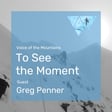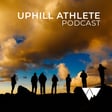Become a Creator today!Start creating today - Share your story with the world!
Start for free
00:00:00
00:00:01

Muscular Endurance for Mountain Athletes
Scott Johnston discusses the evolution of the Uphill Athlete muscular endurance programming that has become a staple in the training of mountain athletes. Learn about the physiology, the intent, and the successful implementation of muscular endurance work in a variety of mountain pursuits.
Transcript
Podcast Introduction
00:00:03
Speaker
Hi, and welcome to another episode of the uphill athlete training talks with Scott podcast. As you know, these are slightly different format. We won't be interviewing anyone today. You just have to listen to me drone on about a subject that I find interesting.
Muscular Endurance Evolution
00:00:17
Speaker
And from some of the feedback I've been getting, other people also find these kinds of peeling the onion down a few layers to look at what kind of underlies some of these particular methodologies that we've used at uphill athlete.
00:00:32
Speaker
Today's talk is going to be about muscular endurance, where I stumbled upon it, how I've used it, how I've seen it evolve, or how I've used it with different types of athletes. Starting with a Genesis story of how I used it on myself.
Benefits of Muscular Endurance Protocols
00:00:50
Speaker
and then began to modify it and make it into kind of what we use today. And I think that'll be interesting for folks because we do find that a lot of people benefit greatly from using the muscular endurance protocols that we've developed. So with that being said, let's get started. The topic for today is a discussion of muscular endurance as it relates to mountain endurance sports.
00:01:19
Speaker
First, I want to cover a little bit of history about this because I think it's important to understand where it came from and how it's evolved. So really what I'd like to do starting off with this is I want to connect the two main principles that undergird the entire uphill athlete training model.
Yuri Verkhoshansky's Training Principles
00:01:40
Speaker
The combination of these principles came to my attention when I discovered the writings of a guy named Yuri Berkashansky. I know many of you have heard me use that, throw that name around. So Yuri was a storied Soviet sports scientist and a coach.
00:01:56
Speaker
who was really one of the key members and pillars of the whole Soviet Intellectual Research Committee in the USSR that produced the bulk of the training knowledge that exists in the world today, frankly.
00:02:18
Speaker
And he worked, he was active from the 50s, all the way until the USSR fell apart. When, when, when the Soviet Union did crumble for Koshansky basically went around selling his skills to national governing bodies of various sports all over the world.
00:02:37
Speaker
And the interesting thing was that everywhere he went across from all kinds of sports, everything from volleyball, to rowing, to distance running, to some of the field events like throwing and jumping, gold medals followed right after he went to these programs. And so there's some continuity there and I think it gives this guy a great deal of credibility.
00:03:03
Speaker
And I think it's also important to realize that kind of acknowledge the debt that we in the West owe to this intellectual kind of pursuits that existed in the Soviet Union.
Impact of Soviet Sports Science
00:03:20
Speaker
And I'm surmising here, but I think in their attempt to be
00:03:23
Speaker
kind of world dominant in everything from space exploration to technology to military might to sports. I think the USSR just went all in and they could do that because they're giant kind of monolithic bureaucracy. On the sports end of things this resulted in kind of a new kind of completely new academic approach to sports science and coaching methods.
00:03:47
Speaker
And it wasn't until after the USSR crumbled that most of this information finally made its way into the West. Now you see lots of writings. And if you know much about the history of, especially strength training, you will recognize in much of what's written in the West today about strength training came from the USSR.
00:04:12
Speaker
So enough of that history. Well, a little bit more history, I guess. This is kind of my personal history.
Personal Success Stories with Muscular Endurance
00:04:17
Speaker
So my experience and my experiments with muscular endurance training goes back to the early 90s when I stumbled upon and used several variations of a circuit style muscular endurance workout given to me by a speed skating coach. I was training with my friend, Ben Huseby, as he prepared for the cross country skiing in the next Olympics.
00:04:41
Speaker
So we started doing these circuit ME workouts a couple days a week in a gym and it was kind of more just as a companion to him because they were kind of brutally hard and we didn't really know what we were doing but we thought it was an interesting experiment. Then about after about eight weeks I ended up heading off to Chamonix to meet with a very strong climbing partner.
00:05:06
Speaker
And what I found when he and I started doing longer and for me, harder alpine routes was that I had never been so strong in the mountains. On the days when my partner, who I
Olympic Success and Endurance Training
00:05:17
Speaker
say was quite a fit, strong guy, needed to rest, I was out doing three-hour runs. And Ben experienced similar gains and then went on to not only make the Olympic team, but have one of the U.S.'s better Olympic results in the 50-kilometer race.
00:05:33
Speaker
As you can imagine, those fantastic results made me an instant convert, and I began to dig deeper, which led me eventually to Vrkashansky's book, The Block Training System for Distance Running, and then to his special strength training manual for coaches, both of which I consider kind of Bibles in terms of these ideas.
00:05:59
Speaker
So that I went also started being into the writings of an Italian distance running coach named Renato Canova and Canova
00:06:11
Speaker
As some of you probably know, I've mentioned him quite a bit before. He's probably the most successful distance running coach in history, having produced more world record holders, more world and Olympic champions in every distance from the 800 to actually all the way to, I think 50 miles or 50 kilometers. I can't remember, but not mountain running, but like just a relatively flat ultra distance event.
00:06:42
Speaker
And the interesting thing is that Brzezinski and Canova crossed paths.
Verkhoshansky's Influence on Italian Distance Running
00:06:49
Speaker
one of Canova, excuse me, one of Rokhoshansky's stops after he started selling his skills to these different national governing bodies was the Italian Olympic Federation, where he began to advise their distance running coaches. And this was in, I think, the early 90s. And Canova at that point was a young upstart coach in that
00:07:17
Speaker
distance running program, national distance running program. And interestingly enough, this was another case where like, I guess it would have been in the very early 90s because in the, I think it was the Atlanta Olympics and maybe in those early 90 years, the Italian distance running program was producing the fastest and best runners in the world. And when one reads
00:07:48
Speaker
into Reed's Canova, you can just see the, between the lines, if you can read between the lines, you can see that the, uh, influence of Bercoszewski. So these two really spectacularly gifted, brilliant coaches helped solidify my understanding of endurance training.
00:08:07
Speaker
And one of the things I'm going to get to a little bit later is that Verkhoshansky conducted a three-year study on middle and long distance runners while he was in the Soviet Union, which was probably doable because I assumed those runners were more like slaves. They had to do whatever the coach told them. So it was easy for them to recruit these fairly high level athletes into these studies where clearly one
00:08:34
Speaker
one group was going to do better than the other. But he used this study to measure the effectiveness of muscular endurance training.
Mechanisms Limiting Endurance Performance
00:08:43
Speaker
And I'll come back to that study in a little while.
00:08:45
Speaker
Next, I want to jump into a discussion of kind of the very simple form of the mechanisms that limit endurance performance and how our uphill athlete methodology, which consists primarily of increasing the aerobic capacity as measured by either the heart rate or the speed at aerobic threshold.
00:09:05
Speaker
and subsequently later layering on some muster endurance work on top of that does directly address those limitations of endurance performance. So this early section's mainly theory and some kind of broad brushed approach. So the main mechanisms for fatigue in physical activity, especially with regards to endurance, is the first one, which is simple, and we're gonna be able to discard it right away,
00:09:35
Speaker
the calcium pump overload. And this manifests itself in very short term, near maximal efforts.
00:09:45
Speaker
Some think about when you try to do multiple sets of lots of pull-ups, when you reach failure after six or 16 reps, whatever it is, that's because the calcium pump has become overloaded and it can no longer move the calcium across the muscle membrane. But that doesn't really impact most of the sports that we deal with very much.
00:10:09
Speaker
Another is lactate accumulation. And in relatively short events, under an hour, let's say, this is the biggie. It's the lactate accumulation that has this negative feedback effect on the working muscles' contractile force, basically causing the athlete to slow down. And it's caused by an over-reliance on fast-switch fibers, which have less aerobic capacity.
00:10:36
Speaker
but it's over-reliance on those fast-twitch fibers in order to produce the level of force output to produce the speed that we're looking for.
00:10:46
Speaker
Another is energy depletion, another source of fatigue is energy depletion. And this is primarily the depletion of muscle glycogen stores, which can partly be offset by eating during prolonged endurance events. So typically that's not a huge issue for people in these multi-hour events because they're relatively, they're very low intensity and the pace is often quite slow. And so it's possible to eat during them without a great deal of
00:11:16
Speaker
either logistical or stomach problems compared to, let's say, a 10K road race where it would be hard to eat a sandwich in the middle of that. But perhaps most importantly for the events that last a lot of many hours, which is kind of really what we deal with mostly, is central nervous system
Central Nervous System Fatigue in Endurance Sports
00:11:37
Speaker
fatigue. And I do plan to do a little more in-depth dive into that at some point too.
00:11:43
Speaker
But basically what this means is that the motor cortex of the brain and the specific motor units can just no longer generate the required signal to fire those leg muscles with enough force and then the athlete is forced to slow down.
00:11:58
Speaker
And while we don't sense that our brain is getting tired, we've all experienced that dead leg feeling, which is how this manifests itself. Think about having been out running in the mountains for many hours, doing lots of uphill and downhill. And at some point, usually in those kinds of runs, you will reach a point where it just feels like your legs aren't working very well anymore. And that is primarily caused by central nervous system fatigue.
00:12:26
Speaker
no less than Stephen Seiler has spoken extensively about this, even though he admits it. I don't know anything about ultra-endurance events, but the main limitation to performance in those has to be neuromuscular fatigue, central nervous system fatigue. Next, I want to talk a little bit about what's the effect of endurance training?
Aerobic vs. High-Intensity Endurance Training
00:12:51
Speaker
We know that
00:12:54
Speaker
endurance training, which we would define as training at or near one's anaerobic threshold. And I want to make a distinction between that and aerobic base training, which is done primarily at an intensity at or below your aerobic threshold.
00:13:10
Speaker
So we have these two types, you know, the actual endurance training is done at a higher intensity, but it stands on top of this aerobic base training that we harp on so much because we find so many of the people that come to us do not have a sufficient aerobic base. And by doing both these types, especially the endurance training, the higher intensity training, it will lead to a reduction in the lactate
00:13:37
Speaker
concentration in the blood during prolonged exercise. And this distinction between these two training methods is important because they both contribute to improved endurance performance. So even in long-duration events that last many hours where the predominant intensity is at and below the aerobic threshold, there's still a need for those athletes to have some training at and above their anaerobic threshold.
00:14:03
Speaker
because this endurance training improves the aerobic capacity of the faster twitch fibers, which increases the size of the pool of recruitable muscle fibers that are available for that motor cortex to recruit and use in this prolonged work. Another thing that's kind of curious here and interesting to note that's a result of endurance training is that muscle fiber types will change in response to training.
00:14:30
Speaker
And prolonged endurance training tends to make the higher force type 2A muscle fibers convert to look a lot more like a slow twitch fiber. In other words, they develop these characteristics like more mitochondria, more aerobic enzymes, so that they begin to have, they develop, that's how they develop more endurance because they start to look more like slow twitch fibers. And then this, by the same token,
00:14:56
Speaker
heavy overload strength training will move the needle in the opposite direction. So one of the things we know is that higher level athletes have a lower lactate concentration for any given power output or speed than a lower level athlete would have.
00:15:15
Speaker
That's because lower level athletes need to recruit more fast-twitch fibers using more of the anaerobic metabolism than a high-level athlete will to produce the same level of speed.
00:15:31
Speaker
But this decrease in lactate concentration as a result of endurance training is believed to be caused not so much, and this is kind of an important thing to grasp, not so much that those high level athletes are producing less lactate. It's that they are able to
00:15:53
Speaker
take up and utilize what lactate that is produced at a faster rate than lower level athletes do. And that happens through this method called the lactate shuttle that was discovered by George Brooks in about 1984, where he found these enzymes that will transport lactate out of working muscle and then other different enzyme that will import that same lactate into
00:16:23
Speaker
adjacent slow twitch muscle fibers and lactate makes an excellent fuel.
Improving Lactate Shuttle Efficiency
00:16:28
Speaker
It can go right into the oxidative mechanism in the mitochondria and be used. So it's really, it's a more potent fuel than let's say fat is because it's already partly broken down, partly converted into acetylcholine or more easily, I should say more easily converted into acetylcholine. But by
00:16:51
Speaker
by improving this lactate shuttle, which happens with endurance training, and by having a big aroic base, which means you have very well adapted pool of slow twitch fibers adjacent to these faster twitch fibers, which can take up this lactate and use it as fuel, the athlete can sustain a higher speed for longer, which is obviously what we're looking for in all this.
00:17:18
Speaker
So this oxidative capacity I've been talking about, I'm sure many of you understand this, but it happens as a result of aerobic-based training, I should say. When the slow twitch fibers become better aerobically adapted, we get more mitochondria in them, higher concentrations of aerobic enzymes so that they can break down
00:17:43
Speaker
Well, they don't break down the fat, excuse me, but they can take acetylcholine and turn it into ATP a lot faster. So those points, I think, are important to grasp because it's this combination of these two concepts, this aerobic-based training coupled with this endurance training, and we're going to talk about how muscular endurance training fits into that, that really formed the foundation of the uphill athlete endurance training model.
Reducing Glycolytic Processes for Endurance
00:18:09
Speaker
Burke Kaczynski, interestingly enough, in some of his early writings, he called this the anti-glycolytic principle. What he meant by that was that appropriate training will have the goal of reducing the involvement of the glycolytic metabolic process. As you know, glycolysis results in lactate production. So the less the athlete has to rely on glycolysis to produce ATP,
00:18:39
Speaker
the lower the lactate levels will be. So I think it's kind of an interesting concept. I mean, it's very direct and speaks to the, what he was trying to achieve. So now let me move on to the muscular endurance. Before I do that, let's talk about the prolonged exercise at below the aerobic threshold improves the aerobic capacity of those slower to its fibers. As I just said, that's the vacuum that I've referred to in writings before the vacuum that sucks up that lactate.
00:19:09
Speaker
And then prolonged training above the aerobic threshold but below the anaerobic threshold is what we would call zone 3, improves the aerobic capacity of this pool of somewhat higher force fibers, often known as type 2A, that are in many cases the limiters to endurance performance.
00:19:29
Speaker
And then training above the anaerobic threshold, you know, closer to the athlete's maximum oxygen uptake, max VO2, improves the aerobic capacity of what are called the type 2B fibers. And these fibers have very little endurance, which is one of the reasons that that intensity level can only be sustained for just a few minutes before the athlete has to slow down.
00:19:51
Speaker
But the degree of the aerobic capacity of all of these fiber types depends on the volume of those fibers' contractile activity. That means that
00:20:01
Speaker
the amount of contraction and the number of times or the rate. So they can, that volume can be increased in two ways, either more contractions per time or just more contractions or longer duration, which is one of that.
Local Muscular Fatigue vs. Oxygen Delivery
00:20:17
Speaker
We know that in general, long duration activities will result in more aerobic adaptations.
00:20:28
Speaker
So here's something critical to understand that, you know, in well trained athletes with a good aerobic base meaning a high aerobic threshold as measured, either by heart rate or power output speed.
00:20:43
Speaker
has been shown many times over to be the significant limiter to submaximal endurance performance. And what that, translating that, what that means is that local muscular fatigue, the kind of fatigue you have all experienced in your legs when your legs get really tired, that that is the limiter. And when I say submaximal, I mean, you know, not close to that max VO2 level.
00:21:08
Speaker
that submaximal endurance performance is limited by this local fatigue. So that this is contrary to what some people think.
VO2 Max vs. Muscle Oxygen Uptake
00:21:16
Speaker
Oxygen delivery to the working muscle is not the limiter and it only becomes a limiter at near maximum intensities that can be sustained just for a few minutes. That's why max VO2 is usually a really poor correlation with, has a poor correlation with endurance performance.
00:21:32
Speaker
Well, the primary limiter is peripheral out in those working muscles and how fast they can take up and use oxygen that is being supplied to them. When we do exceed the limit at which they can do that, then we experience this local muscle fatigue. And how did Vrkaczynski stumbled on this idea by watching some top runners
00:21:56
Speaker
in Olympic competitions, I think primarily in the 800 and 1500, no, the 10,000 meter race as well. And noticing that these guys had tremendous kick, the winners had these big kicks at the end. And he was curious how that could happen. And the way it could happen was this principle of anti, you know, the anti glycolytic training method.
Verkhoshansky's Block Training System
00:22:23
Speaker
As a result of his studies on this, he adapted a periodized training model that he called the block training system. And in that, it's a fairly simple to understand, but somewhat lengthy description I'm not going to go into. We're only interested in one particular part, one of the blocks of that training system.
00:22:44
Speaker
In this one block of it, he introduced this special strength training program that was designed to improve that local muscular fatigue and basically develop more fatigue resistance in those main locomoting muscles. And he called this type of training local muscular endurance, or LME,
00:23:09
Speaker
And when I was working on that first book, I stupidly, I think now in hindsight, contracted this to simply ME for muscular endurance. And in hindsight, I regret having done that because I think local muscular endurance is a more accurate depiction of what this was. And it didn't, it really didn't occur to me that there was gonna, that I would later come back to.
00:23:34
Speaker
regret having done that. But the operative word really is local. And it means that the fatigue limitations the athlete feels in these workouts is localized to the main muscular, the locomotive muscles. It's not that they can't, maybe their heart rate is high, but it's not because they can't supply enough blood. It's this peripheral fatigue. So there's a number of ways of achieving
00:24:02
Speaker
strong local muscular endurance training effect.
Local Muscular Endurance Focus
00:24:06
Speaker
But they all share one thing in common. So the only essential thing that has to be achieved with this type of training is that the athlete must experience localized muscular fatigue. Central system limitations like ventilation rate and heart rate should not be the limiters. So for most athletes, that will imply some sort of overload by added weight or by the intensity, which we'll talk about in a minute for some of these exercises.
00:24:35
Speaker
The exercises used in order to produce this type of fatigue should be semi-sport specific. For instance, you would not be seeing an advantage for your running by doing lots of pull-ups with this type of a program. So it has to be the working muscles here you're working with that you're targeting.
00:25:01
Speaker
And we've developed two principal muscular endurance workouts.
Muscular Endurance Workouts
00:25:07
Speaker
The first one that I use and I recommend use with a lot of runners and skiers, and it even works great for mountaineers, is what our gym-based muscular endurance workout that has progression becomes increasingly difficult. And that's proven quite effective.
00:25:26
Speaker
It involves a fair bit of dynamic and in fact even ballistic jumping. So it might not be appropriate for people who are older and easily injured. So the second method that really works pretty much only for the mountaineering crowd, when it's really simple, you just basically put a heavy pack on and carry it steeply uphill. So the challenge for most people will be finding a steep enough hill.
00:25:53
Speaker
Very few trails will be steep enough. The US Forest Service, I think their gradient recommendation that they try to shoot for it is 11% on a trail. And I have seen that even a 20% grade, which is very steep as most trails go, is probably not going to be steep enough unless the athlete is pretty weak. And then 30% to 50%, which will usually mean straight up the fall line of some kind of steeper hill, will be much more effective.
00:26:23
Speaker
But once again, what we're looking for here is the athlete to feel that local muscular fatigue is the limiter, not their breathing. Selection of the pack weight has a lot to do with the athlete's leg strength and the steepness of the heel.
00:26:39
Speaker
No matter how heavy the pack, you will not see this local fatigue becoming the limiter on a typical 10% trail. So the steeper the hill, the lighter the pack can be. Because most folks don't have access to this sort of terrain, the next best options are in this order, I think, stairs in a tall building.
00:26:59
Speaker
These will also be in the range of around 50%. One athlete I worked with, David Ruski, trained exclusively in a 30-story Manhattan office building on the fire stairs in preparation for his back-to-back climbs of Cho'oyu and Everest.
00:27:19
Speaker
that he did without supplemental oxygen. And there were, amazingly, this is a credit to probably an indication of why he did so well on those climbs. There were some days where he did 10,000 vertical feet in stairs up and down. Shorter stairs can work as long as the time up is at least a few minutes. So we get kind of an endurance training effect. And in those cases, they will definitely want to be descending by the stairs as well.
00:27:45
Speaker
More practical for most of our clients would be a steering machine. These are also in that range of about 50% gradient. And while you don't do all the work of raising your body weight full height of each step because the step is falling away under you as you step up onto it, it still seems to do the trick quite well.
00:28:05
Speaker
Not having to go back down on those stair machines though, it has two effects. One is that it's much more time efficient because you just do the hard work of going up and then you step off and you're done. But the downside of that is you don't get that kind of specific leg strengthening that you get from going downhill. So often need to program in some kind of like step down strength training.
00:28:32
Speaker
Lastly, an incline trainer, which is a steep treadmill can work. Normal treadmills will go to 15%, which usually isn't steep enough for most people.
00:28:44
Speaker
Finally, and the very least desirable, but one that I know a lot of folks who are in our universe have used is a 12 or so inch tall box that they step up and down on with a backpack. Of course, boredom is a big factor on these machines or that box.
Muscular vs. Aerobic Endurance
00:29:04
Speaker
So increasing the size of the vacuum cleaner or the aerobic base is pretty simple. The athlete just needs to do a high volume of aerobic work at or below his or her aerobic threshold. But endurance improvement using muscular endurance is completely different fish altogether. And I want to talk about some of the lessons I've learned and some of the more effective tools that I've developed over the years.
00:29:30
Speaker
Let me get one thing out of the way before we dive in. Muscular endurance can be developed and it will be developed by using conventional high intensity interval training, what we would call in zone three or four type work. The reason for that is that the muscular load or the strength required during high intensity endurance training is a high enough proportion of an athlete's maximum strength that the local muscular fatigue does become a limitation.
00:30:00
Speaker
So running hard uphill is an effective way to develop more muscular endurance. However, those conventional interval training sessions
00:30:09
Speaker
have a much higher global fatigue cost than do the muscular endurance workouts. Secondly, if, as mentioned earlier, the athlete's endurance performance is limited by local muscular fatigue, he or she will not be able to access those higher intensities that are desired in these zone three and four. In other words, they won't be able to sustain that high speed because they will be getting fatigued.
00:30:37
Speaker
And in that case, what a typical interval workout with an athlete whose local muscular fatigue is the limitation will have the athlete slowing down during the later stages of the workout.
00:30:49
Speaker
And so they're no longer really in zone three or four. The pace is slowed down and typically they see a heart rate drop at the same time. And when athletes are going slow, when they're working hard, we're training them to be effortful, slow athletes rather than effortless, fast athletes.
00:31:11
Speaker
For this reason, I use muscular endurance in the early base period for runners and schema folks, so that when we do eventually shift to more conventional high intensity work, their legs are no longer the limiter, and they get much more global benefit from being able to sustain a higher power output for the full high intensity workout.
00:31:34
Speaker
This GMME progressive workout program involves some very dynamic movements that result in really high eccentric loading of the legs. That's why the DOMS is so prevalent. And it's the same reason that mountain runners get such serious leg fatigue when they do a lot of downhill running.
00:31:59
Speaker
And one of the things to note too is it's stronger athletes or perhaps more fast twitch dominant athletes get a whole lot less sore from this workout. Whereas I find that some of our really accomplished runners who are very slow twitch dominant, they almost get crippled by this thing for three days. They're feeling their legs are really wobbly and sore.
00:32:23
Speaker
So make sure you have the first, ease them into this, make sure you do the first couple workouts, or at least, I'd say two to four workouts would be body weight only, and perhaps dialing back on the intensity so they're not jumping as high, so they don't get so stiff and sore. Typically, I never program more than one of these per week of these more dynamic gym-based workouts.
00:32:49
Speaker
So the uphill weighted carries that the Mountaineers will do rarely result in severe gums. And I have had some strong Mountaineers, and some of you may too, have been able to do two of those type of workouts in a week. And I've even used a combination where they do one weighted uphill carry and one gym ME. And that seems, that can work pretty well with a more advanced or stronger athlete.
00:33:15
Speaker
Let's talk for a moment about periodization. I think it's important to understand when to use this. So I found the most success with runners by using this, and the schema crowd, by using these gym-based muscular endurance workouts early in the base period, while when virtually all of their other workouts are low intensity.
00:33:40
Speaker
This provides that ME base I mentioned before for those intervals and the higher intensity stuff and the bigger mileage that's gonna come later as we get closer to the event. So normally I'd plan on eight to 12 weeks of that base period block. And then during that time, the only other hard workouts I give during those early base weeks will be a hill sprint workout, which is kind of more of a max strength or max power type workout.
00:34:10
Speaker
Whereas on the other, the opposite end of this, when I'm dealing with Mountaineers, I use those weighted uphill MEs in the final period as opposed to the early base period. And I think the principle for both of these applications is that in general, the athlete is going to be moving from more general to more specific work as they approach the event.
00:34:35
Speaker
As I mentioned, I almost never use two of these gym ME workouts in a week for runners. It just seems to impact two negatively on their weekly running. So how do you measure the progress with the athlete that's using this? My experience, the easiest way to tell that an athlete is absorbing this muscular endurance work
00:34:56
Speaker
is that they should notice a performance gain from week to week.
Measuring Progress in Muscular Endurance
00:35:00
Speaker
For the weighted carries, this will look like seeing more vertical done faster from week to week. And for runners, they'll begin to see those improved running times despite still carrying a significant fatigue load, like I mentioned just a few minutes ago.
00:35:19
Speaker
Now, if they fail to improve and there are no other obvious problems, then they are not adapting because the workouts are either too challenging or there is insufficient recovery between them. We know this training works and it works fast. So if you're not seeing progress, something needs adjusting. The first thing to do is to push the next ME workout
00:35:39
Speaker
out a day or a few days and perhaps lighten the intervening workouts to allow the athlete to feel the progress of their improvement so when they're a little more rested. This is not a case of, you know, more is better. It's such a powerful training effect. It's easy to overdo.
00:35:58
Speaker
There's another concept I want to mention that I think, you know, a tribute to Bercuszewski again.
Long-term Training Effects
00:36:03
Speaker
I think this is a real gem of wisdom from him, and that is something he turns or calls, I should say, the long-term delayed training effect. Now,
00:36:14
Speaker
That's a lot of words. What it basically says is that when an athlete has done a long block of concentrated loading in a particular area, such as like a 12-week muscular endurance program, that the training effect from that muscular endurance block of training will last about as long as the block did. So that means his athletes can kind of coast along on the gains they made for another 12 weeks.
00:36:44
Speaker
Of course it's going to decline a bit.
00:36:47
Speaker
but it doesn't take very much to maintain that. This long-term delayed training effect is a really important concept for coaches to understand. It allows you to plan an athlete's next few weeks or even months in a very general or conceptual manner, not on a day-to-day, so that you can exploit the gains that they've made in muscular endurance leading up to either the next phase of their training or to some final event that you're training them for.
00:37:16
Speaker
So as I said before, this, this allows the runner to move into a more conventional high intensity interval training block, which in its in and of itself, as I mentioned earlier, those high intensity intervals will do a lot to maintain that muscular endurance. Um, I want to talk about an example, a few examples of this so you can see how I've used it in the past and why I'm so sold on it.
00:37:41
Speaker
So a few years ago, I was helping Luke Nelson prepare for a race in Chamonix called the Tour de Géal. It's 205 miles long and has 80,000 feet of vertical gain and loss. We used a 16-week training block, muscular endurance training block, during which he completed 14 of our uphill athlete, Jim and me workouts in a progressive way. Eight weeks before the race,
00:38:09
Speaker
We dropped the ME and moved to one time per week of an interval session on a hill near his home that he calls stupid steep. Has an average grade of 45% and gains just over 1,000 feet. He's trained on this for years, so we have a lot of data for comparison.
00:38:29
Speaker
Now interestingly, after that muscular endurance block leading into this race, his very first stupid steep interval session after this block was three times stupid steep.
00:38:41
Speaker
All three of those reps were at or below his previous PR on that hill. And his legs felt really tired still because he's carrying a lot of fatigue from that block of muscular endurance. In this preparation phase, in this high intensity interval block, we did that workout four more times, so a total of five times.
00:39:04
Speaker
And each time, as the fatigue for the muscular endurance wore off, his times improved until his PR had dropped over two minutes to around 12 minutes for that 1,000-foot climb. It's a little, I think it's 11 or 1,200 feet. The feedback I got after the race was that Luke said his legs never got tired, and his last few miles were his fastest of the race. He'd never experienced this level of fatigue resistance in a race before.
00:39:31
Speaker
Now I've used this similar approach in prepping David Goodler for his Shishapengma climbs with Uli Steck. And while they didn't get to the summit, they did climb both the British and the Spanish routes on the south face within one week, both done as single push climbs. And much to his joy, because he was very concerned about this, David had no problem sharing the lead and step kicking with Uli.
00:39:58
Speaker
I've also had similar results with a South African woman that I trained who won the Tour de Glossier, which is another one of those crazy long races out of Cormier, Italy, which is 280 miles with 104,000 feet of vertical. And I use that same method with the male seventh place finisher in that race, who's a doctor from California.
00:40:27
Speaker
So these are just a few of the higher profile success stories. And I'm sure some of you have your own success stories using muscular endurance. The point is though that this stuff works and it really works infallibly if it's used correctly. Well, something I want to mention here about the Mountaineers is that their ME block of training will
00:40:46
Speaker
continue up until their taper starts. And then that long-term delayed training effect allows you to confidently tell them that even if they have a long travel and approach to their climb, like they were going to the Karakorum or the Himalaya, the ME that Muscular Endurance that they've built will last the trip, provided they've had a long enough block, of course. If their travel and approach are long, if they have a really long
00:41:16
Speaker
approach, then they don't really need a taper at all. They can use that approach, the travel time, the approach as their taper. If, on the other hand, they're going to hit the ground running with a land in their new place and they're going to start climbing right away, then I'd give them a two week taper before from that type of weighted carry.
00:41:35
Speaker
So going back to the runners for a minute, because I think this is one of the places that this is most revolutionary.
Application to Mountaineering Tasks
00:41:41
Speaker
I mean, obviously it makes a lot of sense that, you know, Mountaineers job is to carry a heavy pack steeply uphill. So if we do that kind of training, put a heavy pack on them and have them go uphill, they're probably going to see gains. I mentioned earlier that Brzezinski
00:41:57
Speaker
had done a three year experiment, which included two groups of middle and long distance runners. So over those three years, I'm going to give you some kind of meta data from this. I can provide you with the source material if you're interested. But over those three years, the ME training group, he separated into control group and ME training group.
00:42:19
Speaker
The ME training group reduced their running distance by 8%, while the control group increased theirs by 25%.
00:42:28
Speaker
The ME group increased their muscular endurance training volume by 28% over those three years, while the control groups, they did a more general strength training volume, increased by 17%. But the ME group did roughly 30 times more strength work as measured by tons lifted during these ME sessions.
00:42:51
Speaker
So they took very different approaches, distinctly different approaches with these two different groups. And despite the much lower running volume that the ME group ended up with, they improved their 3,000 meter time trial by 28% during those three years.
00:43:11
Speaker
And the control group only improved theirs by 16%, despite their 25%. They're much higher training volumes than the muscular endurance group was using. For instance, in their final year, total kilometers run.
00:43:27
Speaker
for the muscular endurance group was 1,976 kilometers. The control group, on the other hand, the one who's using conventional training had run 4,600 kilometers. So well over twice the training volume of running volume.
00:43:46
Speaker
So a couple of other really interesting performance metrics that improved much more in the muscular endurance group were that their stride length increased by 6%. You know that stride length is strongly correlated with running economy, and running economy is strongly correlated with running performance. Another thing that improved greatly was their speed at their anaerobic threshold, which is one of the best correlations to race performance. It improved by 10%.
00:44:16
Speaker
And also, interestingly, even though they weren't doing any map strength training, their maximum speed for 20 meters increased by almost 50%. So when I first came across these kind of these numbers and read this book.
00:44:32
Speaker
I had to read it a couple of times to let it sink in, frankly, to let it register. How could it be that the holy grail of running, the distance run, did not seem to hold up in this case? Well, I played around with some ME workouts with cross country skiers in the past and seeing really great results. I'd never used it with ultra runners before I did that experiment with Luke.
00:44:55
Speaker
And for Luke, it was interesting because Luke has a really demanding job where he's often standing in the operating room for eight to 12 hours several days a week between work and family his training time is really limited.
00:45:10
Speaker
As an example, leading up to the Tour de Géon, during those nine months leading prior to that, he averaged less than 50 miles of running per week. That's an almost unheard of low volume of running for a 200 mile race with so much vertical. And for me, Luke's success was the proof of concept that this ME approach worked for altered distance, even in various deep mountain terrain.
00:45:35
Speaker
And I have a theory that I'm going to propose here as to why this works. And as I mentioned before, the predominant fatigue mechanism in these ultra long events is central nervous system fatigue.
00:45:51
Speaker
These ME workouts seem to increase the fatigue resistance of the working muscles. It is my belief that traditional training for long duration events that involves a high volume of running also can impart this muscular endurance training effect, which will improve the fatigue resistance of those same muscles, but at what cost? Running 100 mile weeks with 25,000 vert in them has
00:46:19
Speaker
very high global fatigue load. It increases dramatically, increases the potential for overuse injuries. And it takes a lot of time, which most people won't be able to afford. And also for runners that are not living close to mountains, these muscular endurance workouts can replace a good deal of that hilly running.
00:46:42
Speaker
So I hope I've been able to demonstrate the value and the validity of this muscular endurance training for mountain athletes. Thanks, bye. Thanks for joining us today. For more information about what we do, please go to our website, uphillathlete.com.



















